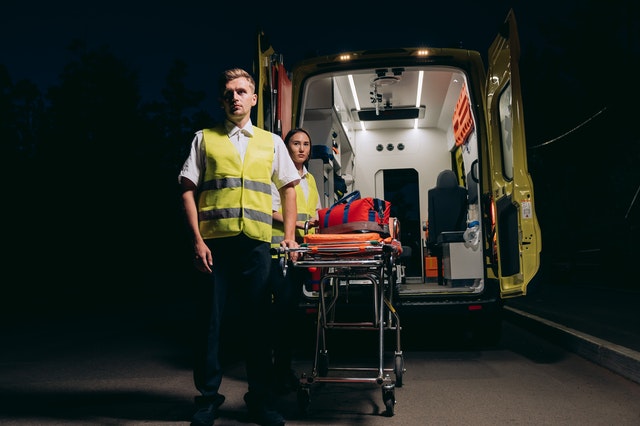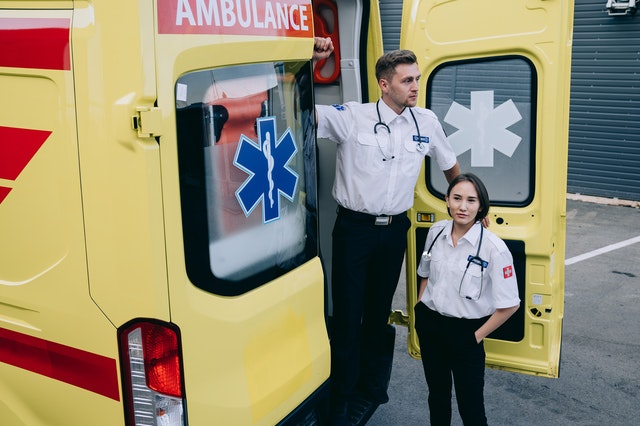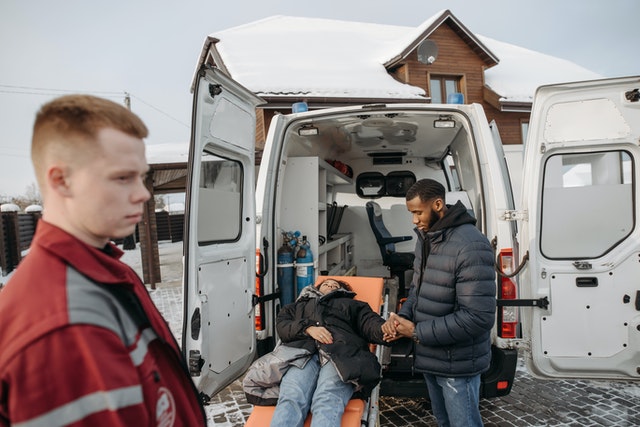EMTs perform basic, non-invasive interventions at emergency locations to assist save lives and limiting harm, and they may also provide out-of-hospital care. EMTs utilize their abilities to safely transport patients, perform cardiopulmonary resuscitation (CPR), deliver oxygen, administer glucose and treat patients suffering from asthma attacks or allergic reactions, all under medical supervision.
An individual must finish an operationally approved program of study and pass the New York State Emergency Medical Technician examination to work as an EMT in New York State.
Keep reading our article to know how to become an EMT in NY in detail. And don’t forget to take our free EMT practice test to pass the real exam.
Overview

EMTs and paramedics in New York must take and pass a state-sponsored EMS course and exam. New York does not use the National Registry of Emergency Medical Technicians Exam, which is being adopted by numerous states in the United States.
With the exception of various local protocols, the New York EMT and paramedic exam covers the identical material as the NREMT exam.
What are the requirements of NY EMT certification?
Here are the pre-requirements for those who want to become an EMT in New York:
- EMT candidates must be at least 18 years old
- EMT candidates should have completed an EMT training program that has been approved by the state
- A valid CPR (Cardiopulmonary Resuscitation) certificate is required
- Candidates must provide legal proof of their citizenship in the United States
- Any mental or physical illness should not be present in the candidate
- Every applicant must be able to communicate in English
- A criminal background check is required of every candidate.
Aside from that, there are some further requirements to meet, such as submitting an application and any related fees, as well as passing a state-recognized practical exam.
If you want to know the average EMT salary in every state, you can try to visit our blog.
How to become an EMT in NY?

Step 1: Complete EMT training in New York
Before applying for certification, the individual must complete EMT training. The candidate can contact any community institution that offers training programs or the local EMS department.
The Bureau of Emergency Medical Services ( BEMS) of the New York State Department of Health offers certification at the following levels:
- Certified First Responder (CFR)
- Emergency Medical Technician-Basic (EMT-B)
- Advanced Emergency Medical Technician-Intermediate (AEMT-I)
- Advanced Emergency Medical Technician – Critical Care (AEMT-CC)
- Advanced Emergency Medical Technician-Paramedic (AEMT-P)
The upcoming course is announced to each Regional EMS Council. The Regional Council should be your first point of contact if you want to learn about upcoming courses in your area. Only approved Course Sponsors by the New York State Bureau of EMS are permitted to conduct the New York State Bureau of EMS certification courses.
Emergency Medical Technician-Basic (EMT-B), is based on National EMS Standards but includes some state-specific content. The National EMS Standards are used in a New York Emergency Medical Technician curriculum, although there is some state-specific information as well. The New York version of the EMS Standards has been made available to instructors and students by the Bureau of EMS.
The program will take 150 to 190 hours to complete. Students must fulfill performance standards before proceeding to the examination stage. This includes meeting Professional Rescuer CPR requirements.
Step 2: Take the examination
A written certification exam and a Practical Skills Examination, or PSE, are required of prospective licensees. Students’ training instructors usually provide them with test dates for both the PSE and the written exam.
EMT candidates must complete six PSE stations. The following criteria are used to evaluate all candidates:
- Trauma and medical assessment
- Bag valve mask
- Cardiac management/ AED
The other three skills will differ. Supine or seated spinal immobilization, as well as long bone, joint, or traction splint immobilization, are all options for candidates. The candidate may provide extra oxygen, reduce bleeding, and manage shock, as well as administer airway adjuncts and suction.
The Bureau of Emergency Medical Services has supplied skill sheets that break down each tested ability into steps, click here to see. Some steps are worth a certain amount of points, which varies. Others are marked as essential, indicating that they must be passed in order for the candidate to pass the station.
A candidate who fails three or more stations must complete a refresher course before retesting, according to the PSE skill sheets document.
As of early 2016, New York practical skills examiners are using psychomotor skill sheets that were first used in December of 2012. The document will be changed as soon as the examination is revised, according to the Bureau.
A state-specific written test is used in New York. It is not taken until after a candidate has passed the PSE.
A schedule of upcoming written tests has been issued by the Bureau. The exam will be given at Long Island City and Fresh Meadows in 2015-2017. The application deadline is roughly two months before the test date, so students should apply as soon as possible after starting the course. Exams are usually scheduled to begin at 7:00 p.m.
Before requiring a refresher, a candidate may be permitted two chances at the written examination. Request forms for test scheduling can be available on the Bureau’s website. The examination may be conducted on-site in some cases.
Maybe you want to know How To Pass Your NREMT Cognitive Exam?
Step 3: Background Check
The candidate must pass a criminal background check to complete the certification process. The candidate might do so by contacting his or her course coordinator.
Step 4: Submit an application for a license
EMT licenses in New York are obtained through the state. Students are advised to follow the rules supplied by their class instructor because testing is handled by New York State.
EMTs from other states
 Out-of-state EMS professionals have a variety of possibilities. Reciprocity is defined by the New York Bureau of EMS as being eligible for licensure without having to undergo an initial or refresher training.
Out-of-state EMS professionals have a variety of possibilities. Reciprocity is defined by the New York Bureau of EMS as being eligible for licensure without having to undergo an initial or refresher training.
State licensing or (in some cases) requirements met while working in the US military or the National Park service may be used to give reciprocity to an out-of-state EMT. EMTs and AEMTs from all 50 states, as well as the District of Columbia, are eligible for reciprocity.
A state-licensed Emergency Medical Technician must have completed a training program based on national requirements in order to qualify. During the prior 18 months, he or she must have passed both a practical and a written exam. The New York licensing agency can accept both state-constructed examinations and examinations that are under the banner of the National Registry of Emergency Medical Technicians.
BEMS-approved schools may accept out-of-state EMTs for testing.
Reciprocity applicants must fill out a separate application. Regulations and policies are prone to change, so out-of-state EMTs should be alert.
The licensing office in New York will require some information from the other state. This is done through the use of a verification form.
Advanced placement in New York EMS programs may be available to medical professionals. However, this is not considered reciprocity.
EMTs are at the forefront of emergency medical care in the US. Once you’ve fulfilled all four steps, you’ll be able to apply for and earn an EMT position in your state. By now you know how to become an EMT in NY. We hope that the info we’ve provided will help you finish your career as an exceptional EMT. Thank you for reading!

PCCN vs CCRN: Which Certification Should I Take?
In this discussion, we will examine the fundamental distinctions between PCCN vs CCRN certifications, allowing you to make an informed and right decision about which certification is best for your nursing career progression.
June 20, 2023

Is PCCN Worth It? A Comprehensive 2024 Study Guide
In this article, we will provide all the enrollment criteria, how to apply, whether is PCCN worth it for you to obtain, and how to get a high mark.
June 20, 2023

PCCN Requirements - How to Become a Progressive Care Certified Nurse?
To become a progressive care nurse, you must first obtain the PCCN certification. This post will help you understand PCCN certification, PCCN requirements, and efficient approaches to obtaining this certification.
June 20, 2023
